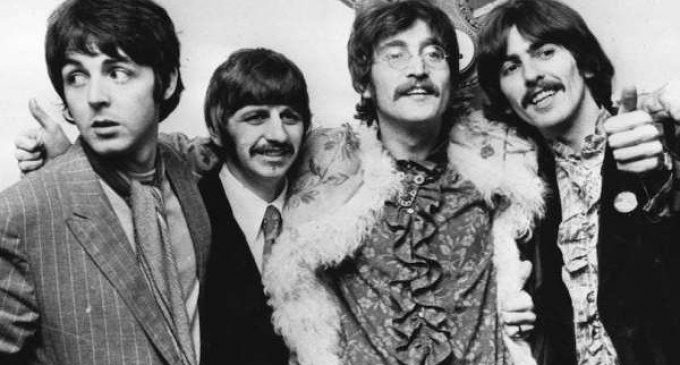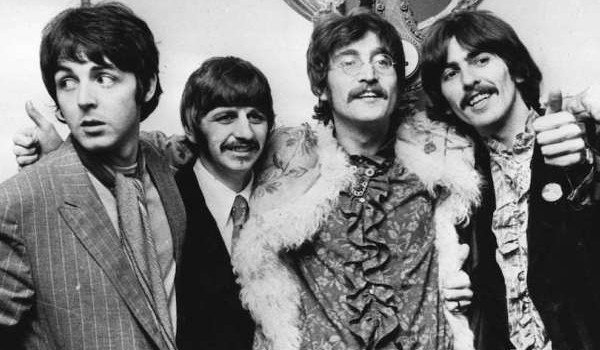The Beatles and Charles Manson – An Inside Look – The Good Men Project

John Lennon told me years afterward that Manson was a maniac. -Ivor Davis
By
In August of 1969, no one was better positioned to research Charles Manson’s followers than the sharp and savvy reporter, Ivor Davis. As Foreign Correspondent for the London Daily Express, Davis was living in Los Angeles, only miles from the Manson Family’s “home” at the Spahn Movie Ranch on the outskirts of Hollywood. And for a decade, Davis had his finger on the very pulse of the Sixties; he had been an integral part of every major event.

Davis had toured with The Beatles on both the 1964 and 1965 North American Tours and was with The Beatles on that momentous evening when they met Elvis. He was also right beside Bobby Kennedy when Kennedy was tragically assassinated in the summer of l968. As one of Ronald Regan’s “Boys on the Bus,” Davis was assigned to travel with the B-movie actor who ended up with a starring role—as President of the United States. And, back in the early Sixties, he was smuggled onto the campus disguised as a student to witness the riots and bloodshed as James Meredith became the first African American admitted (albeit reluctantly) to the campus of the University of Mississippi in Oxford. The press was banned from the campus — but Davis posed as an Ole Miss student to make front-page news covering the historical events.
So, it wasn’t surprising that in December l969, Davis made his way to the Spahn Ranch to investigate the sordid proceedings that led up to the Manson Family’s grisly Tate/La Bianca murders. Then, he recorded the facts that he uncovered in the chilling, award-winning work, Five to Die, the first book to chronicle life with Manson and his band of killers.
Now, 50 years later, Ivor Davis has just released a completely new and expanded work on the subject entitled, Manson Exposed: A Reporter’s 50-Year Journey into Madness and Murder which became an Amazon e-book bestseller the first week it was released. I was thrilled to be able to sit down with Ivor and talk about what he’s experienced and discovered about the case in the five decades since the horrific events occurred.
Kessler: Ivor, please take us back to 1969, when you were living in Los Angeles and heard about the gruesome atrocities committed by the Manson Family. What did you do at that point? And what did you find out?
Davis: Don’t forget communications back in l969 were not what they are today. News did not flash around the world in a nanosecond as happens with the Internet today. So all I knew in August l969 was that there had been some murders in a quiet, supposedly safe neighborhood in a canyon in the privileged enclaves of Beverly Hills. And so as a foreign correspondent for a big overseas daily newspaper I rushed to the scene to try and find out what had happened. And it took almost a full day before the facts emerged—and we learned of the true carnage that had unfolded in the hilltop mansion, with one of the victims the beautiful actress Sharon Tate, who was eight months pregnant when she was killed and who was the wife of the famous film director Roman Polanski.
Kessler: So, after days of gathering facts from the Manson Family members at the ranch, you sat down to write your first book on the subject, Five to Die. Is it true that this book was so in-depth and so factual that it was accepted as part of the court record? And if so, how did this come about?
Davis: Here’s what happened. For four months I pursued the case—as the police tried in vain to solve those heinous murders. In Hollywood, the movie stars like Steve McQueen, Warren Beatty, and Frank Sinatra were terrified. Many rushed out and bought guns and hired security guards. No one felt safe. It wasn’t until December 1st, 1969 that Los Angeles Police Chief Edward Davis revealed the names of the suspects — and said their leader was a man named Manson who lived with his “Family” on an old movie location called The Spahn Ranch.
I immediately rushed to the Ranch, a decrepit old place, where much to my surprise I was able to interview several members of the Manson Family — who were not involved in the killings. And the story they spun was beyond belief! Just before the trial began, I did that quick book — Five to Die — and then later learned that most of the details from the book were used by the prosecution as the motive of the murders: a blueprint for the district attorney.
Kessler: What were those shocking details?
Davis: Manson Family members (Brooks Poston and Paul Watkins) told me that Manson brainwashed his followers by insisting that the lyrics from some of the songs in The Beatles 1968 White Album, (“Helter Skelter,” “Revolution,” and “Rocky Racoon”) were, in fact, secret messages…..sent to Manson by The Beatles, warning him of an impending race war in America. In fact, Manson played The Beatles’ music ten times a day as he handed out LSD and mescaline to his stupid disciples.
Well, knowing The Beatles’ songs, I quickly realized that the thesis was utter rubbish. And it was. Yet, much to my surprise, when the trial began, Vincent Bugliosi, the deputy district attorney, fed that motive to the jury. And they believed it. Because after a year-long trial Manson and his gang of killers were convicted of first-degree murder!
Kessler: Now, 50 years later, you’re released a greatly-expanded new work on Charles Manson and the horrific murders, Manson Exposed. What is new and different in this book that was not found in Five to Die?
Davis: So much more! My first book never covered the trial. My new book covers the whole Big Picture — right up until Manson’s death in 2017. And over the years, I interviewed dozens of people involved in the case. Vincent Bugliosi’s deputy, deputy district attorney Stephen Kay who has, since the trial, devoted his life to making sure the Manson disciples are not given parole. I talked extensively with Roman Polanski, the Oscar-winning film director who lost not only his wife but his unborn son. Also, I spent time with Doris Day’s son, Terry Melcher. Terry was a hotshot Hollywood record producer, who was persuaded to audition Charles Manson, who desperately wanted to be a rock star. But Melcher decided Manson didn’t have what it took to become a star — and dropped him. But the shocking important fact: Melcher and his girlfriend, actress Candice Bergen, lived in the Cielo drive murder house. However, they had moved out three months before Sharon Tate and her husband Polanski moved in. Melcher said for a long time he was terrified that Manson had sent his gang out to kill him…in revenge because he was furious at being rejected by the record producer. But that wasn’t the case.
Kessler: As you just mentioned, Manson firmly asserted, in court, that The Beatles’ song, “Helter Skelter” inspired him to plan and direct the Tate/La Bianca murders. What was Manson’s exact claim? For those who aren’t Beatles fans, please tell them what the song entails.
Davis: Yes, let me elaborate a bit on that vitally important issue. ”Helter Skelter” is not — and I repeat not about suggesting people go out to kill. Listen to those lyrics — it’s Paul McCartney’s song about the magical, frantic feeling of a fairground ride. John Lennon told me years afterward that Manson was a maniac — and again, John suggested that everyone listen carefully to the words in the song “Revolution.” “Revolution” clearly states, “If you want money for people with minds that hate, All I can tell you is brother you have to wait!” It’s a song about peaceful, organized, planned change. It’s a song about changing yourself. What has that song to do with stabbing people?” said the angry John.
Kessler: One of the incidents that you didn’t discuss in Five to Die is the threat on your life that occurred as a result of your investigation into the Manson case. Tell us what happened, if you don’t mind.
Davis: Very simply, on the first day of the murder trial, in July 1970, Lynn “Squeaky” Fromme, one of Manson’s most devoted followers who was not involved in the murders, was sitting on the sidewalk outside the Los Angeles Hall of Justice where the trial was playing out. She recognized me immediately as the writer who had been the author of Five to Die — a book that slammed Manson and his crazy lifestyle. I had met her at the Spahn Ranch in December 1969. In a sweet, little girl voice, she called out, “Hello Ivor…do you know what it feels like to have a sharp knife slid down your throat?”
I was not amused—and took it as a threat. I called my wife and told her to take our daughter Rebecca, who was one year old and move out of our house into a friend’s house. I knew what horrendous things the Manson gang was capable of.
Kessler: Ivor, this summer we were treated to the cinematic story of that summer in Hollywood in which the Manson murders took place via the film “Once Upon a Time in…Hollywood.” How close to the truth was the film?
Davis: The movie was fascinating. It captured l969 and the mood, the music, and atmosphere in Hollywood so perfectly. It also captured the atmosphere at the Spahn Movie Ranch — an eerie place full of young women who did whatever Manson ordered — including murder. But the actual movie script is—well, a fairy story and doesn’t tell the real facts of those killings. But I don’t want to elaborate or spoil it for those who haven’t seen the Quentin Tarantino film. I will say that I am sure it will be nominated for Oscars in 2020 — particularly for stars Leonardo DiCaprio and Brad Pitt. And maybe Margot Robbie (Best Supporting Actress) who plays Sharon Tate. I will reveal this: Manson….has a very, very brief walk-on role!
Kessler: Well, Ivor, I sincerely appreciate the gift of your time in setting the records straight about The Beatle’s role in this awful event as well as the gift of your expertise in delving into the facts in the Manson Case. I’ve read both of your books, and although they are frightening, they are truly superb. I highly recommend them!
In fact, all of your books, including your recent children’s book on the rise of The Beatles entitled, Ladies and Gentlemen, The Penguins! are remarkable. And as you well know, I could not have written Vol. 4 in The John Lennon Series, Should Have Known Better, without your guidance, interviews, and the day-to-day information you provided about The Beatles’ 1964 North American Tour in your book, The Beatles and Me on Tour. It is amazingly detailed and accurate!
—
This post was previously published on CultureSonar and is republished here with permission from the author.
—
Source: The Beatles and Charles Manson – An Inside Look – The Good Men Project




There are no comments at the moment, do you want to add one?
Write a comment